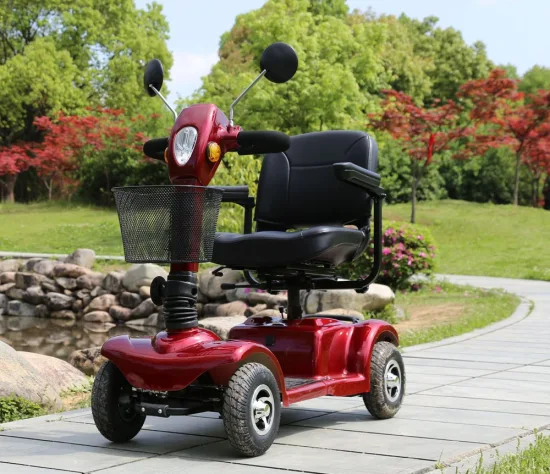Many people can’t live without mobility scooters, as they allow them to be independent and make traveling easier. However, just like any other car, they do occasionally have problems. Knowing how to troubleshoot common scooter problems can help you solve them quickly and keep your scooter running smoothly. This guide will tell you everything you need to know to diagnose and fix common mobility scooter problems.
My scooter won’t start
If your mobility scooter won’t start, there could be a number of issues. First, check the power. Make sure it’s fully charged and properly connected. Over time, the battery can lose its charge or become disconnected, preventing the scooter from starting. Check the fuse and make sure the battery is normal. A blown fuse will stop the flow of electricity, so replacing the fuse may solve the problem. Finally, make sure the emergency stop switch isn’t turned on and the key is in the “on” position.
Loses Motivation Quickly
A battery that drains quickly can mean a number of things. First, know the lifespan of the battery. Batteries that are too old often lose their ability to hold a charge. If the battery is not too old, make sure it is fully charged and that the charger is working properly. If the charger is damaged, the battery may not be fully charged. Also, check the scooter’s wiring for damage or loose connections, which can affect the battery’s performance.
Scooter moves slowly
There are a number of factors that can cause your scooter to move slower than normal. First, make sure the battery is fully charged. If the battery is low, the scooter may move more slowly. Next, check the drive system, including the motor and gears, for signs of damage or wear. Also, make sure the speed setting on the control panel is correct. Sometimes speed limits can be accidentally set too low.
Right brake not working
Brake failure can be very dangerous. First, check the brake pads for wear. If worn, replace it. If you notice any signs of damage or stretch in your brake cables, they may not be working properly. Make sure the brake lever is working properly. If not, adjust it. If your brake problems persist, you may want to have a professional look at your brake system to see if there is a problem.
Rough or Vibrating Ride
A rough ride or excessive vibration can be painful and a sign of deeper problems. Check your tires for proper tire pressure and wear. Unevenly worn or underinflated tires can make riding difficult. Check your suspension for signs of damage or misalignment. If your scooter has front or rear suspension, make sure it is working properly and that all components are secure. If the problem persists, there may be a problem with your scooter’s frame or alignment that needs to be addressed by a professional.
Error Message in the Control Panel
If your control panel displays an error message, consult your scooter’s owner’s manual for specific instructions on how to fix the problem indicated by the error code. Common errors can be caused by problems with the battery, motor, or the system itself. You can fix the problem by following the instructions in the manual. If the error persists or the manual does not explain how to fix it, you may need to call a professional technician to diagnose and fix the problem.
When the scooter jerks or stutters
If your scooter jerks or stutters while riding, this could indicate a bad motor or drive system. First, look for loose or damaged parts in the motor connections and wiring. Check the motor brushes for wear. A motor that is not working properly may have worn carbon brushes. Also, check the throttle and control system for signs of malfunction. A thorough inspection can help determine where the problem lies.
The scooter will not charge
If your scooter will not charge, first check: the charger and its connections. Make sure the charger is connected properly and is working properly. Check the battery terminals for corrosion or loose connections. If necessary, clean the connections and make sure they are connected properly. If the charger and USB cable are working fine, but the scooter still won’t charge, the battery may be damaged and need to be replaced.
Conclusion
When there is a problem with a scooter, you should check the battery, drive system, brakes, tires, and control panel in a certain order. By paying careful attention to each possible problem, you can often solve the problem hold a charge. When the battery is more than two years old, it might be time to get a new one.
FAQs
What should I do if the brakes on my scooter don’t work?
Check the brake lever, brake pads, and brake cables. Change the brake pads that are worn out, look for damage in the cables, and adjust the lever if needed. If the problems don’t go away, get a professional to do a full inspection.
Even though the battery is charged, why does my scooter move so slowly?
Check the drive system for damage or wear, make sure the speed settings are right, and look for any mechanical problems that could affect how well it works.
What does it mean when the control panel of my scooter shows an error message?
Error messages can mean that there are problems with the motor, battery, or other parts of the system. Check the scooter’s manual for specific error codes and steps on how to fix them. If you need to, get help from a professional.
What can I do to keep my scooter from breaking down in the future?
Checking the battery, inspecting the tires, and adjusting the brakes on a regular basis can help keep problems from happening. If you follow the manufacturer’s maintenance schedule and fix small problems right away, your scooter will stay in good shape.




